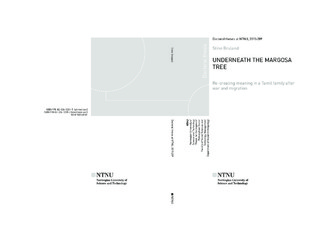| dc.description.abstract | As of today, more than half of Sri Lanka’s entire pre-war Tamil population live outside the island due to the brutal thirty year long civil war. In this dissertation I explore how one extended family that used to live together in one village, the ur of “Korte”, strive to re-orient themselves in times of rupture and loss when living dispersed throughout the world. Based on fieldwork among members of the family living in Jaffna, Oslo, Paris and London, I focus on their new practices of maintaining family bonds across distances. I discuss how the family members born and raised in Korte experience having lost their past life, and how they try to re-create meaning in their new situation.
I argue that sondam (family/relatives) and ur (natal village/home) together with the person are remembered and perceived as an enmeshment - inextricable elements of each other. Sondam and ur is thus crucial for being a Tamil person and for living a morally good and meaningful life. Living dispersed from both sondam and ur therefore becomes a challenging situation. In their quest to re-create meaning I discuss the family members’ new practices of being together and maintaining the unity of ur-sondam. I take a broad material perspective to look at how the family member’s engagement with certain objects produces emotions of presence and absence, closeness and distance to their relatives (sondam) and their past life in the ur in setting such as; arranged puberty ceremonies; commemoration of dead soldiers of the Liberation Tigers of Tamil Eelam (LTTE); the exchange of money and gifts. Taking a Deluzian material approach to signs I argue that the sensorial quality of such objects affects those engaged. The objects and produced emotions are again associated to known concepts, ideals and thoughts based on notions of sondam and ur, contributing to making sense of their exile experience – or not. A main argument is that the relative’s engagement with particular objects produces specific affects that brings forth experiences of their past life. In this process, LTTE’s aesthetic world seems to most effectively reorient the family members in their new situation. | nb_NO |
